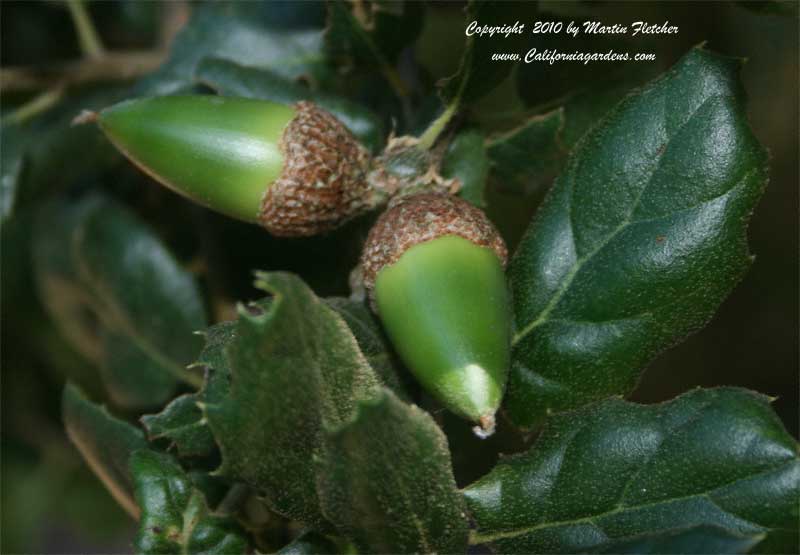Quercus agrifolia - Coast Live Oak
Quercus agrifolia or Coast Live Oak has a pronounced impact on the way we landscape. The Coast Live Oak is protected by numerous city and county ordinances. These ordinances often provide conditions and restrictions for the trimming and removal of trees. Most often if you want to cut something more than 4" diameter you probably need a permit. The Coast Live Oak has a lifetime similar to ours. Quercus agrifolia grows rapidly during the first 30 years of its life, often attaining its mature height. If conditions are good Quercus agrifolia will continue to grow an ever thicker trunk for the next 40 years though the top of the tree will not increase much except around the midriff during this middle aged period and may thin at the tips of the branches. As the trees age, much like us, it is an ever more difficult battle to keep up with what we could once do. The Coast Live Oak rarely makes it much past the Century mark. It is interesting seeing early California Mission photos and no oaks, since they dominate the landscapes around the missions now. A map of where Quercus agrifolia grows closely matches a population density map of where we live, more of us along the coast with some scattered into warmer inland locations and below 5000 feet. Quercus agrifolia grows from streambeds to north facing slopes and out in full sun where soil conditions are more prime. The Coast Live Oak is abundantly fruitful from seed.Quercus agrifolia is a host for the Western Tussock Moth Caterpillar, Hedgerow Hairstreak, California Sister Butterfly and the Mournful Duskywing. Changing from a dry natural rainfall regime to an irrigated landscape is really hard on the trees. Changing the grade around the trees, either up or down is really hard on the trees and will significantly reduce their lifespan and their ability to stay upright. Fertilizing nearby plants often kills the naturally associated fungus that coats the roots of the trees allowing non-native fungus free rein. The roots of the trees extend well past the shade of the foliage with the greatest density of roots in the top 3 feet of the soil. Quercus agrifolia drops a lot of debris. This self mulching creates a cool loose soil that maintains moisture well. Attempting to mimic this with woodchip mulch can cause problems if the mulch rests against the trunk of the tree. I have seen some pretty big Coast Live Oak trees get moved, sometimes with moderate success. Quercus agrifolia has been cut for hedges and it works surprisingly well for this. The Coast Live Oak makes for an interesting bristly bonsai. Lawns under oaks work fine, if the lawn was there first. If not, watering the lawn will dramatically shorten the lifespan of the tree and increase the odds it will fall on you. All that debris, your pool man would hate you if you put a pool by this tree or regularly thank you for insuring his continued regular employment, or both. I have often heard the line from a tree trimmer on a budget that he will only be around once every 5 years, so a hard pruning is a good idea for the safety of the landscape. I don't think so. If the trunks of the Coast Live Oak are exposed to sunlight they sprout an amazing number of small shoots. If these last long enough and turn into branches they are poorly attached to the trunk and often fall off at inopportune times, never the good thing for shiny cars or wandering gardeners. In the end the Coast Live Oaks can be spectacular if well maintained, but they sure make us work hard to keep them healthy if we don't leave their growing area natural. For a suitable list of plants for planting in the shade of Quercus agrifolia see our Dry Shade Garden List

Ripe acorns and foliage of Quercus agrifolia - Coast Live Oak. High resolution photos are part of our garden image collection.
The other oaks featured on this site:
Quercus berberidifolia * Scrub Oak
Quercus douglasii * Blue Oak
Quercus durata * Leather Oak
Quercus garryana * Oregon White Oak, Garry Oak
Quercus john-tuckeri * Tucker's Oak
Quercus kelloggii * Maple Leafed Oak
Quercus lobata * Valley Oak
Quercus muehlenbergii * Chinkapin Oak
